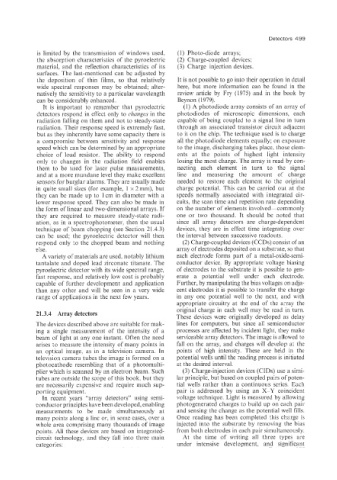Page 516 - Instrumentation Reference Book 3E
P. 516
Detectors 499
is limited by the transmission of windows used, (1) Photo-diode arrays;
the absorption characteristics of the pyroelectric (2) Charge-coupled devices:
material, and the reflection characteristics of its (3:) Charge injection devices.
surfaces. The last-mentioned can be adjusted by
the deposition of thin films, so that relatively It is not possible to go into their operation in detail
wide spectral responses may be obtained; alter- here, but more information can be found in the
natively the sensitivity to a particular wavelength review article by Fry (1975) and in the book by
can be considerably enhanced. Beynon (1979).
It is important to remember that pyroelectric (1) A photodiode array consists of an array of
detectors respond in effect only to changes in the photodiodes of microscopic dimensions, each
radiation falling on them and not to steady-state capable of being coupled to a signal line in turn
radiation. Their response speed is extremely fast, through an associated transistor circuit adjacent
but as they inherently have some capacity there is to it on the chip. The technique used is to charge
a compromise between sensitivity and response all the photodiode elements equally; on exposure
speed which can be determined by an appropriate to the image, discharging takes place, those elem-
choice of load resistor. The ability to respond ents at the points of highest light intensity
only to changes in the radiation field enables losing the most charge. The array is read by con-
them to be used for !aser pulse measurements, necting each element in turn to the signal
and at a more mundane level they make excellent line and measuring the amount of charge
sensors for burglar alarms. They are usually made needed to restore each element to the original
in quite small sizes (for example, 1 x 2mm), but charge potential. This can be carried out at the
they can b’e made up to 1 cm in diameter with a speeds normally associated with integrated cir-
lower response speed. They can also be made in cuits, the scan time and repetition rate depending
the form of linear and two-dimensional arrays. If on the number of elements involvedLcommonly
they are required to measure steady-state radi- one or two thousand. It should be noted that
ation, as in a spectrophotometer, then the usual since all array detectors are charge-dependent
technique of beam chopping (see Section 21.4.3) devices, they are in effect time integrating over
can be used; the pyroelectric detector will then the interval between successive readouts.
respond only to the chopped beam and nothing (2) Charge-coupled devices (CCDs) consist of an
else. array of electrodes deposited on a substrate, so that
A variety of materials are used, notably lithium each electrode forms part of a metal-oxide-semi-
tantalate and doped lead zirconate titanate. The conductor device. By appropriate voltage biasing
pyroelectric detector with its wide spectral range; of electrodes to the substrate it is possible to gen-
fast response, and relatively low cost is probably erate a potential well under each electrode.
capable of further development and application Further, by manipulating the bias voltages on adja-
than any other and will be seen in a very wide cent electrodes it is possible io transfer the charge
rapge of applications in the next few years. in any one potential well to the next, and with
appropriate circuitry at the end of the array the
original charge in each well may be read in turn.
21.3.4 Array detectors These devices were originally developed as delay
The devices described above are suitable for mak- lines for computers. but since all semiconductor
ing a single measurement of the intensity of a processes are affected by incident light, they make
beam of light at any one instant. Often the need serviceable array detectors. The image is allowed to
arises io measure the intensity of many points in fall on the array, and charges will develop ai the
an optical image, as in a television camera. In points of high intensity. These are held in the
television camera tubes the image is formed on a potential wells until the reading process is initiated
photocathode resembling that of a photomulti- at the desired interval.
plier which is scanned by an electron beam. Such (3) Charge-injection devices (CIDs) use a sin+
tubes are outside the scope of this book, but they lar principle, but based on coupled pairs of poten-
are necessariiy expensive and require much sup- tial wells rather than a continuous series. Each
porting equipment. pair is addressed by using an X-Y coincident
In recent years “array detectors” using semi- voltage technique. Light is measured by allowing
conductor priiiciples have been developed, enabling photogenerated charges to build up on each pair
measurements to be made simultaneously at and sensing the change as the potential well fills.
many points along a line or, in some cases. over a Once reading has been completed this charge is
whole area comprising many thousands of image injected into the substrate by removing the bias
points. All these devices are based on integrated- from both electrodes in each pair simultaneously.
circuit technology, and they fall into three main At the time of writing all three types are
categories: under intensive development, and significant

